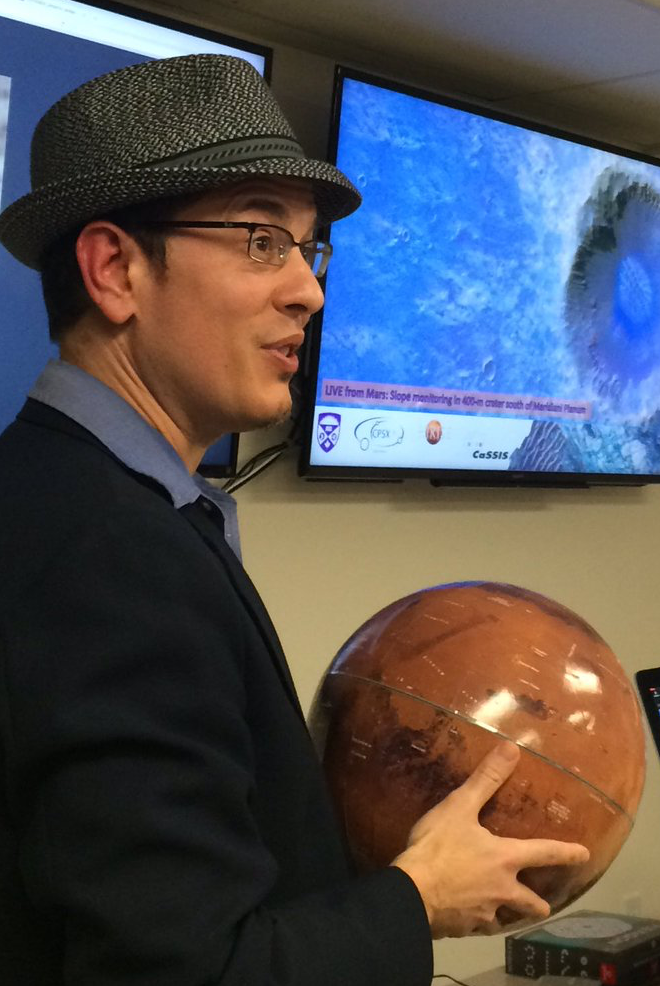
Biography
Dr. Livio Tornabene is a SETI and Western University Research Scientist, as well as an Adjunct Professor at WesternU. Dr. Tornabene has over 20 years of experience with planetary missions, and maintains involvement, as a science team member with the High-Resolution Imaging Science Experiment (HiRISE) on the 2006 Mars Reconnaissance Orbiter (MRO), and more recently as Co-Investigator on the Colour and Stereo Surface Imaging System (CaSSIS) on the ExoMars 2016 Trace Gas Orbiter and on the Panoramic Camera (PanCam) on the 2022 ExoMars Rosalind Franklin rover. He has provided mission operations training to over 20 individuals through his involvement with MRO/HiRISE and TGO/CaSSIS, which he uses to teach students and other staff about the intricacies of planning and optimizing high-resolution VNIR imaging or Mars.
In general, Tornabene employs a remote sensing data synthesis approach to investigate and answer geologic questions about terrestrial planetary bodies. His primary science focus is on surface processes, particularly impact cratering as a geologic process and the origin, evolution, and aqueous alteration of planetary crusts with emphasis on Mars. The datasets that he most often employs include visible-near infrared high spatial resolution images (morphology/mapping); moderate to high spatial resolution stereo image-derived Digital Terrain or Elevation Models (3D geometry and morphometry) and multispectral and hyperspectral datasets spanning visible to thermal infrared wavelengths (composition, physical and thermophysical properties of surfaces). Besides this, his work more recently focuses on CaSSIS image simulation, color calibration, empirical corrections for reducing atmospheric scatter and isolating surface signals, the development, and production of higher-level data products for CaSSIS.
Education:
- 2007 Ph.D., Univ. of Tennessee, Earth and Planetary Sciences, Knoxville
- Advisors: Drs. Harry “Hap” Y. McSween Jr. & Jeffrey E. Moersch
- Dissertation title: Remote sensing of impact crater-exposed subsurface lithologies & Martian rayed crater systems (e–link: http://etd.utk.edu/2007/TornabeneLivio.pdf)
- 2001 M.S., Univ. of South Florida, Geological Science, Tampa
- Advisor: QDr. Jeffrey G. Ryan
- Thesis title: The Gatun Structure: A geological assessment of a newly recognized impact structure near Gatun Lake in the Republic De Panama (e-thesis: http://purl.fcla.edu/fcla/etd/SFE0000019)
- 1996 B.S., Univ. of Florida, Dept. of. Geology, Gainesville.
Honors and Awards:
- NASA – Ames Group/Team Honor Award – FINESSE (2017)
- Prose Award (as a co-author on a book chapter in Encyclopedia of the Solar System,Edited by Tilman Spohn, Doris Breuer and Torrence Johnson, Elsevier Publishing) – American Publishers Awards for Professional and Scholarly Excellence (2015)
- NASA Group Achievement Award – MRO-HiRISE Operations and Science (2011)
- Charles Lindbergh Fellow at the Smithsonian Institute – National Air and Space Museum, Center for Earth and Planetary Studies (2010)
- NASA Group Achievement Award – MER Operations and Science – year 3 (2006)
- Excellence in Ph.D. research award ($300), Planetary Geosciences Institute, Univ. of Tennessee (2006)
- Awarded MEPAG Travel grant ($750) (2005)
- NASA Group Achievement Award – MER Operations and Science – year 2 (2005)
- Awarded “Outstanding oral presentation at an international conference”, Planetary Geosciences Institute, Univ. of Tennessee (2005)
- NASA Group Achievement Award – MER Operations and Science – year 1 (2004)
- Awarded MEPAG Travel grant ($700) (2004)
- Excellence in Graduate research award ($300), Planetary Geosciences Institute, Univ. of Tennessee (2003)
- Acceptance to NASA/PGandG Hawaii Volcanology Workshop, August 2003 (2003)
- Sigma Xi Student Research Grant ($2100) (2001)
- Geological Society of America Student Research Grant ($900) (2000)
Publications
- Munaretto et al. Multiband photometry of Martian Recurring Slope Lineae (RSL) and dust-removed features at Horowitz crater, Mars from TGO/CaSSIS color observations, submitted to PSS May 2021, revised Dec 2021, accepted Feb 2022.
- Pajola et al. Geology, in-situ resource-identification and engineering analysis of the Vernal crater area (Arabia Terra): a suitable Mars human landing site candidate, PSS, accepted Feb 2022.
- *Parkes-Bowen et al. A CaSSIS and HiRISE Map of the Clay-bearing Unit at the ExoMars 2022 Landing Site in Oxia Planum, submitted to PSS May 2021, accepted Jan 2022.
- *Sacks et al. Hargraves Crater, Mars: Insights into the internal structure of layered ejecta deposits, ICARUS-D-21-00284, accepted Dec 15, 2021.
- *Valentinas et al. Color and Multi-Angular Observations of Martian Slope Streaks, PSS, accepted, Nov 2021, doi: 10.1016/j.pss.2021.105373.
- *Morse Z. R., Osinski, G. R., Tornabene, L. L. et al. (2021) Detailed Morphologic Mapping and Traverse Planning for a Rover-based Lunar Sample Return Mission to Schrödinger Basin, Planet. Sci. J., doi: 10.3847/PSJ/ac0728.
- Neish, C. D., Cannon, K. M., Tornabene, L. L Flemming, R. L., Zanetti, M. and *E. Pilles (2021), Evidence for glass-bearing surfaces on lunar impact melt deposits, Icarus, doi: 10.1016/j.icarus.2021.114392.
- *Morse Z. R., Osinski, G. R., Tornabene, L. L. et al. (2021) Morphologic mapping and interpretation of ejecta deposits from Tsiolkovskiy Crater, MAPS, doi: 10.1111/maps.13650.
- Mandon, L. et al. (2021) Morphological and spectral diversity of the clay-bearing unit at the ExoMars landing site Oxia Planum, Astrobio, doi: 10.1089/ast.2020.2292.
- *Caudill, C. M., Osinski G. R., Greenberger R., Tornabene, L. L. and 3 others (2021) Origin of the degassing pipes at the Ries impact structure and implications for impact-induced alteration on Mars and other planetary bodies, MAPS, doi: 10.1111/maps.13600.
Click here for a complete list of publications by Dr. Tornabene